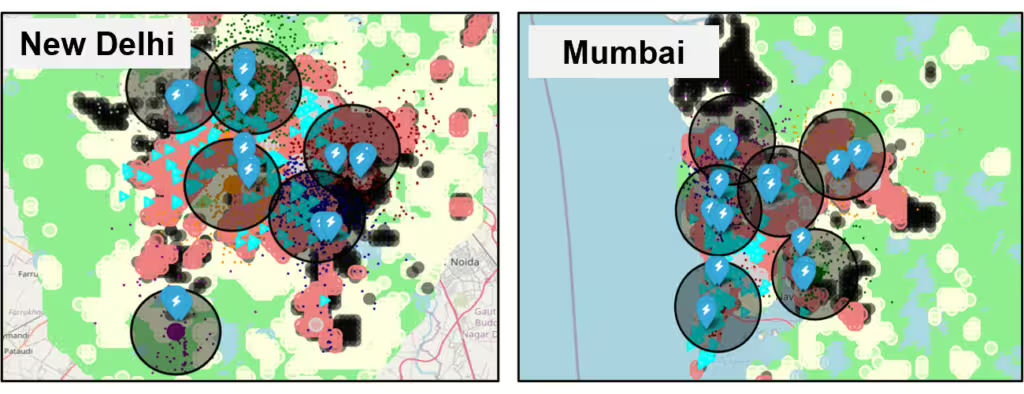This post was originally published on WBCSD
Optimizing EV charging infrastructure planning can result in 13% reduction in fuel costs and 70% reduction in charging time.
Decarbonization of India’s trucking industry is a critical imperative
India’s freight sector is expected to grow from over 3 trillion ton-kilometers annually today to nearly 10 trillion ton-kilometers by 2050. This presents a significant challenge, with the country’s road transport sector being dominated by ICE trucks and handling 70% of the nation’s freight and having a disproportionately large environmental footprint.
Delving deeper into the transport sector reveals that, despite comprising less than 3% of India’s total vehicle stock, trucks consume approximately 30% of the nation’s diesel and contribute to over 30% of road transport emissions, making its decarbonization a critical imperative.
Collaboration across private and public sectors accelerates electrification in India
In India, public and private stakeholders are increasingly recognizing e-trucks as a promising solution. Moreover, initiatives such as the World Business Council for Sustainable Development’s Zero-Emission Vehicle Emerging Markets Initiative (ZEV-EM-I) and NITI Aayog-led e-FAST India are convening stakeholders across the value chain to work towards largescale freight electrification. These joint efforts have already resulted in a demand signal of 5,000+ e-trucks by 2027 and ~7,700 e-trucks by 2030.
Charging infrastructure remains the prime challenge to unlocking India’s transition to e-trucks
As e-truck adoption gains momentum, the success and pace of this transition are heavily reliant on the availability of a reliable network of strategically located public fast-charging infrastructure. Given the capital intensity of fast-charging infrastructure for e-trucks, it is crucial that chargers are installed in locations with high demand and utilization. However, India’s nascent e-truck market presents several challenges that hinder charging infrastructure planning:
- Uncertain demand: The adoption of e-trucks varies significantly across different regions and industries in India, making it difficult to predict where and when charging infrastructure will be needed, potentially resulting in either under-utilization of chargers or shortages.
- Operational complexity: E-trucks operate on diverse routes with varying load capacities and schedules. Determining optimal locations for charging stations requires a detailed understanding of these operational patterns, which is challenging to achieve without a centralized data-sharing framework.
To overcome these challenges, consolidating data related to freight transition plans and operational requirements is useful. Securely sharing this data allows charge-point operators (CPOs) to align public charging infrastructure development with actual and predicted demand, thereby ensuring investments are made where the demand is and will be needed. Consequently, fleet operators can avoid over-investment in underutilized and captive charging infrastructure, leverage opportunities for infrastructure-sharing, and avoid costly delays due to inadequate public charging infrastructure.
A consortium businesses demonstrates the value of data-sharing
The National-level Data-Sharing Platform, under the aegis of ZEV-EM-I, was announced at COP28 in December 2023 with an aim to convene stakeholders across the value chain to share data on their current and planned e-truck fleets for enabling the assessment of infrastructure needs and informing infrastructure deployment.
In its first phase, the consortium demonstrated the value of data-sharing through a pilot modelling exercise, which was led by Fujitsu for 4 months. The initiative leveraged Fujitsu Uvance’s offering, EV-Shift that can simulates EV deployment plan and Social Digital Twin technology to identify optimal charging locations to underpin Gentari’s fleet operations in New Delhi and Mumbai. A brief overview of the process is outlined below.
Data collection: Over a 4-month period, Gentari provided data, predominantly tracked through telematics devices, for the modelling exercise. This enabled Fujitsu to model real-world scenarios to assess charging needs accurately.
EV related data provided by Gentari
 State of Charge State of Charge |
 Energy Consumption Energy Consumption |
 Delivery Schedules Delivery Schedules |
||
|---|---|---|---|---|
| Origin and destination coordinates for each trip | Battery charge levels before and after each trip | Detailed records of energy used per trip | Exact time of starting and stopping for each trip | Distance covered during each trip |
Route simulation and analysis: Feeding the collected data into the EV-Shift solution, Fujitsu simulated the routes taken by Gentari’s fleet. This helped visualize vehicle movement patterns, identifying where charging was likely needed.
Cluster analysis: Fujitsu performed a cluster analysis to identify key areas with high charging demand. This was crucial in determining locations where multiple routes converged, allowing for efficient infrastructure placement.
Incorporation of external datasets: Additional datasets, including existing charging infrastructure and population density, were integrated to identify gaps in current infrastructure and predict future demand.
Identification of optimal locations: Fujitsu used EV-Shift solution to identify 48 high-priority locations across New Delhi and Mumbai where new charging stations would be most effective.
Charging infrastructure at these locations would ensure increased operational coverage, reduced charging time, and minimized operational delays for Gentari’s fleet while assuring utilization for the CPOs.

Companies sharing data generate substantial operational benefits
The pilot demonstrated that optimized charging infrastructure can improve efficiency and reduce costs for fleet operators. The following is an overview of the potential impact on Gentari’s fleets in New Delhi and Mumbai across select KPIs, based on the assumption that vehicles are operational 24 hours.

The pilot provided several key insights to guide the development of future charging infrastructure, highlighting critical strategies and considerations for effective implementation, such as –
- Integrate demographic data into infrastructure planning to ensure charger placement reflects population demands.
- Maximize fleet data collection to inform better operational decision-making and infrastructure planning.
- Aggregate data from fleet operators to identify and prioritize locations with the highest charging needs.
- Collaborate with local governments to secure strategic locations and streamline the permitting process.
- Design for scalability to ensure infrastructure can expand with EV demand, adding chargers and increasing capacity.
The consortium expands its impact and creates a Charging Infrastructure Task Force
Having demonstrated the value of data-sharing for charging infrastructure planning, the second phase will focus on establishing a national-level Charging Infrastructure Task Force under the ZEV-EM-I Data-sharing Platform, which was proposed during the CEO Roundtable in June, in India. This task force will develop a centralized data-sharing framework, mobilize stakeholders to collect data, and identify infrastructure requirements and investment opportunities along key transport corridors. By participating, organizations will facilitate the development of a robust network of strategically placed charging infrastructure, ensuring a seamless transition towards e-trucks in India’s freight sector.
This aligns with WBCSD’s Industrial Transformation Pathway (ITP) and the Breakthrough Agenda’s priorities for the road sector. The objective is to cut global transport emissions in line with a +1.5°C climate scenario by accelerating the adoption of zero-emission technologies and advancing system-wide climate solutions through collaborative efforts in green freight corridors and urban hubs.
For more information, please contact Gunay Huseynalizadeh at huseynalizadeh@wbcsd.org.
The post Digital collaboration for EV charging infrastructure substantially reduces costs and improves operations first appeared on WBCSD.




0 Comments